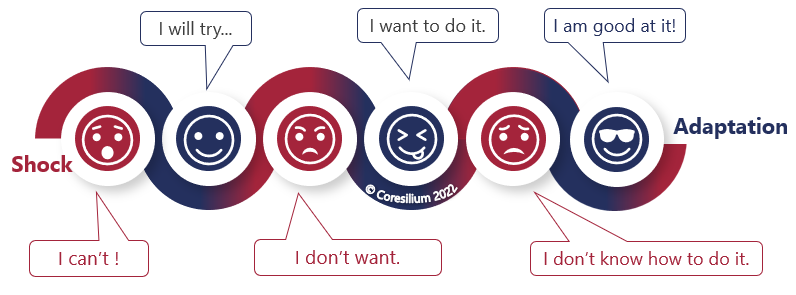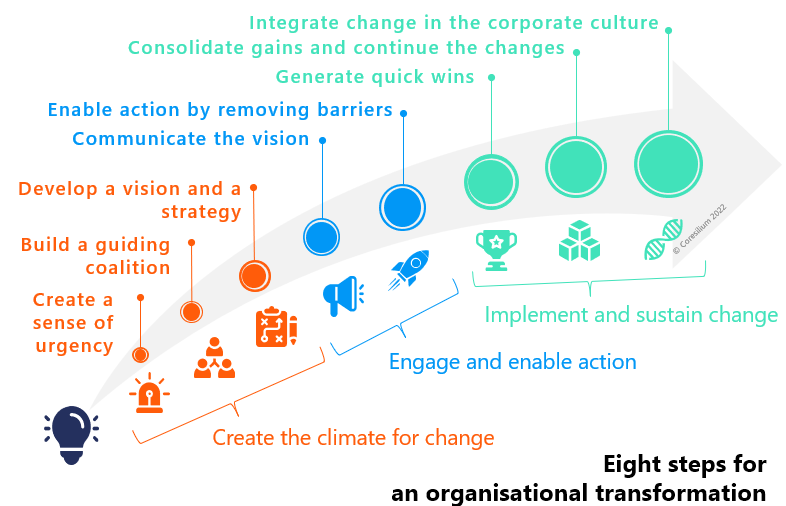One of the key principles of change management is to create (or give) meaning. They all revolve around the vision, the meaning given to the change or to the organizational transformation. But what meaning are we talking about?

The meaning of change
The meaning is often covered up by the change and the actions to be taken. When teams are informed of a change, we explain to them what is changing and the impact on their daily lives. Stakeholders must be told why the change is taking place. Indeed, it is utopian to try to convince people of the benefits of change: no one likes to be told what to think and what is good for them. Moreover, for the same change, everyone will react according to his or her sensitivity. The benefits for one may bedrwbacks for another, it is not possible to convince a whole group with one argument.
Only the company’s values and vision are common to all. Therefore, we must align the meaning with these values. In addition, since the organization works for the customer, it will have identified its added value for the customer, and will have no problem demonstrating how the change enhances the value proposition to the customer. Because your teams care about your mission and the value you bring to your customers, they will adopt the changes more quickly if they understand their interest in it. Ultimately, understanding the impact I have in my work is an intrinsic motivator.
However, care must be taken not to justify everything on behalf of the client. Teams cannot be fooled, they are able to know what is good or not for the customer. A change that does not bring benefits must be questioned before being implemented, and must be explained in all transparency. In organizations that are resistant to change, there is often a lack of trust between the operational and executive teams.
The process of grief and change
Many people have been interested in the process of grief, to better understand it, Elizabeth Kubler-Ross formalized in 1969 five stages. More recently, Margaret Stroebe and Henk Schut have determined that the process is more complex and is rather an oscillation between two states: sovereignty and regret for the past, and looking to the future. These stages are experienced by any human being confronted with a change that puts an end to a known situation. After learning about the change (the initial shock), and before we can explore the unknown and adapt to the new situation, we alternate between a state of sadness and acceptance.

The responses and reactions they express will help you to better identify the steps. From I won’t to I don’t want, then I can’t. They will then try and succeed.
A change often results from a project, which has its own methodology. You can use different tools to implement your change, such as PDCA. However, to structure your way of doing things, I suggest you follow John Kotter‘s eight steps of organizational transformation. It is possible to adapt his model to changes of any scale.
- Create a sense of urgency
- Build a guiding coalition
- Develop a vision and a strategy
- Communicate the vision
- Enable action by removing barriers
- Generate quick wins
- Consolidate gains and continue the changes
- Integrate change in the corporate culture
These 8 steps are themselves included in 3 major steps, which are none other than the PDCA:
- Create the climate for change (plan)
- Engage and enable action (do – achieve)
- Implement and sustain change (check & act)

Now, how do we implement change?
I’ll give you an example, using Kotter’s steps, with an unappreciated change: removing Internet access to all computers controlling industrial equipment.
Create winning conditions
Step 1: Create a sense of urgency. We just stopped a cyber-attack, but that’s really lucky. It was by chance that one of our SOC analysts took the time to analyze a log on this production server. She quickly escalated the problem, and after isolating the machine (and disrupting production for an hour), we changed the passwords that appeared to have been compromised. It’s just a matter of days before another such attack occurs. We know that these servers are vulnerable, but we have not yet found a solution to update or replace them. The impact could be a complete blockage of our system, the loss of our data or its disclosure.
Steps 2 and 3: Build a coalition and develop a vision and strategy. Several members of the management team: IT, human resources, production, finance and communication came together to discuss the risk and potential solutions. Together, the team ensured that the solution was aligned with the company’s values, and that it was the best option to continue serving our customers. We are approaching a critical period and they need us to carry out their operations.
Mobilize and facilitate actions
Steps 4 and 5: Communicate the vision and enable action. It was the production manager who communicated the message live to the teams. The main points were then posted on the intranet, and all managers had access to additional information to support the needs of each staff member.
Supporting change
Step 6 and 7: Generate quick wins, consolidate and continue the changes. The IT team now communicates more transparently about the security of our information system. It has a section next to the health and safety section. It lists incidents that could have had dramatic consequences, and gives tips on how to improve our security posture.
Step 8: Integrate change in the corporate culture. We now have a clearer cybersecurity policy. The teams know what they need to do to protect our information system. Of course, many people miss the days when they could surf the Internet from their computer. They also miss the days when they didn’t wear earplugs and protective eyewear. But they understand that these inconveniences are for the good of all.
